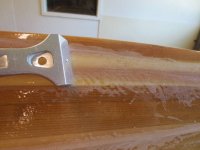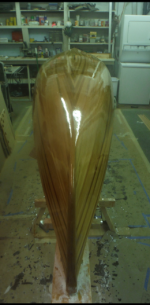Thanks Sven, Cruiser, and Jim. All your advice has been extremely helpful!
This morning I sanded down the entire hull. It definitely took care of the bubbles. I definitely should have gone straight to glassing after seal coating. I think sanding sort of rendered useless the seal coat.
My wife volunteered to be pinch hitter, since my buddy who was going to assist was unavailable. So we glassed today! I am sure glad I had her help, and would surely have messed something up if I tried to go it alone. Everything seems to have gone well. The knuckle really slowed me down, and as a result I didn't get a perfectly even wet out before things started getting goopy. I am not horribly concerned, though. Everything is sufficiently wet out, and there seem to by no bubbles yet. I think it helped to crank the shop temp up to 80F, and let is drop a bit about half way through. Yesterday I was working at 75. My staple holes weren't really filled by the seal coat - at least not after sanding. I noticed they seem to absorb resin out of the glass. It seems that no amount of resin would change it. The glass is definitely wetted by the resin, but not as much as elsewhere. I tried to capture the issue in a picture below.
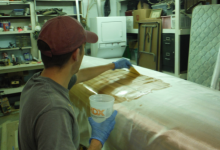
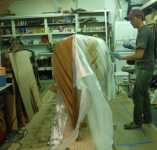
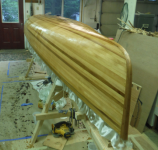
Stable holes, any advice?:
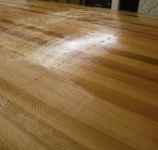
We will be doing the second layer in an hour or so.
Jim,
I cut my strips on my table saw. My options were somewhat limited, as far as reasonably price clear-ish cedar. I ended up getting a bunch of 18' 1x2 planks and ripping them down to quarter inch strips. I did bead and cove. It was the first time I really used a router, other then messing around, so they weren't perfect. Everything has worked out better then expected for the most part, though. The herring bone football strips was really visually appealing to me, but it really stretched my abilities. It was difficult to get the angles just right, especially with the bead and cove, and I was rushing to close the hull because I was excited. not the greatest combination. I ended up having to do a bit of back filling with epoxy where gaps formed. Similar situation on the two-piece stem.
As for your suggestion about filling the holes. How I wish I had done so! It didn't seem typical to do so, so I left them. I think that may have been a mistake.
This morning I sanded down the entire hull. It definitely took care of the bubbles. I definitely should have gone straight to glassing after seal coating. I think sanding sort of rendered useless the seal coat.
My wife volunteered to be pinch hitter, since my buddy who was going to assist was unavailable. So we glassed today! I am sure glad I had her help, and would surely have messed something up if I tried to go it alone. Everything seems to have gone well. The knuckle really slowed me down, and as a result I didn't get a perfectly even wet out before things started getting goopy. I am not horribly concerned, though. Everything is sufficiently wet out, and there seem to by no bubbles yet. I think it helped to crank the shop temp up to 80F, and let is drop a bit about half way through. Yesterday I was working at 75. My staple holes weren't really filled by the seal coat - at least not after sanding. I noticed they seem to absorb resin out of the glass. It seems that no amount of resin would change it. The glass is definitely wetted by the resin, but not as much as elsewhere. I tried to capture the issue in a picture below.



Stable holes, any advice?:

We will be doing the second layer in an hour or so.
Jim,
I cut my strips on my table saw. My options were somewhat limited, as far as reasonably price clear-ish cedar. I ended up getting a bunch of 18' 1x2 planks and ripping them down to quarter inch strips. I did bead and cove. It was the first time I really used a router, other then messing around, so they weren't perfect. Everything has worked out better then expected for the most part, though. The herring bone football strips was really visually appealing to me, but it really stretched my abilities. It was difficult to get the angles just right, especially with the bead and cove, and I was rushing to close the hull because I was excited. not the greatest combination. I ended up having to do a bit of back filling with epoxy where gaps formed. Similar situation on the two-piece stem.
As for your suggestion about filling the holes. How I wish I had done so! It didn't seem typical to do so, so I left them. I think that may have been a mistake.
Last edited:

